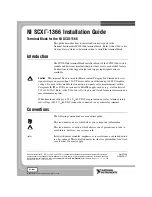
Chapter 1: Product Overview 1-27
G1 Sleeping
A
computer
state
where
the
computer
consumes
a
small
amount
of
power,
user
mode
threads
are
not
being
executed,
and
the
system
appears
to
be
off
(from
an
end
user’s
perspective,
the
display
is
off,
and
so
on).
Latency
for
returning
to
the
Working
state
varies
on
the
wake
environment
selected
prior
to
entry
of
this
state
(for
example,
whether
the
system
should
answer
phone
calls).
Work
can
be
resumed
without
rebooting
the
OS
because
large
elements
of
system
context
are
saved
by
the
hardware
and
the
rest
by
system
software.
It
is
not
safe
to
disassemble
the
machine
in
this
state.
G0 Working
A
computer
state
where
the
system
dispatches
user
mode
(application)
threads
and
they
execute.
In
this
state,
peripheral
devices
(peripherals)
are
having
their
power
state
changed
dynamically.
The
user
can
select,
through
some
UI,
various
performance/power
characteristics
of
the
system
to
have
the
software
optimize
for
performance
or
battery
life.
The
system
responds
to
external
events
in
real
time.
It
is
not
safe
to
disassemble
the
machine
in
this
state.
Under
the
G1
sleeping
state
ACPI
defines
levels
of
system
sleep
state
support.
The
7402
supports
the
following
sleeping
states:
•
S0:
Normal
Powered
‐
On
state
•
S1
(Standby):
The
S1
sleeping
state
is
a
low
wake
latency
sleeping
state.
In
this
state,
no
system
context
is
lost
(CPU
or
chip
set)
and
hardware
maintains
all
system
context.
The
7402
does
not
support
the
S2,
S3
(Suspend
to
RAM),
or
S4
(Suspend
to
Disk)
sleeping
states.
Reference
the
ACPI
Specification
for
details.
Peripherals:
ACPI
defines
power
states
for
peripherals
which
are
separate
from
the
system
power
state.
The
device
power
states
range
from
D0
(fully
‐
on)
to
D3
(off)
It
is
the
responsibility
of
the
driver
developer
for
each
peripheral
to
define
and
support
the
available
power
states.
Содержание RealPOS 70
Страница 1: ...NCR RealPOS 70 7402 Release 1 4 User Guide B005 0000 1463 Issue N ...
Страница 18: ...xvi ...
Страница 96: ...3 34 Chapter 3 Touch Screen Calibration Windows MT 7 12 ...
Страница 103: ...Chapter 4 Touch Screen Calibration Windows MT 5 64 SR4 4 7 8 Select Finish 9 Select Calibrate ...
Страница 119: ...Chapter 4 Touch Screen Calibration Windows MT 5 64 SR4 4 23 2 Select the Advanced button ...
Страница 122: ...4 26 Chapter 4 Touch Screen Calibration Windows MT 5 64 SR4 3 Select the Touchdown option 4 Select Close ...
Страница 124: ......
Страница 127: ...Chapter 5 Touch Screen Calibration Windows MT 5 64 SR6 5 3 6 Select Next at the Welcome screen ...
Страница 130: ...5 6 Chapter 5 Touch Screen Calibration Windows MT 5 64 SR6 10 Select Finish 11 Select Calibrate ...
Страница 146: ...5 22 Chapter 5 Touch Screen Calibration Windows MT 5 64 SR6 11 Select the Touchdown option 12 Select Close ...
Страница 148: ...5 24 Chapter 5 Touch Screen Calibration Windows MT 5 64 SR6 ...
Страница 152: ...6 4 Chapter 6 Touch Screen Calibration DOS ...
Страница 218: ...9 18 Chapter 9 Installing the Terminal in an Integrated Configuration ...
Страница 223: ...Chapter 10 2x20 Customer Display Interface 10 5 CP437 ...
Страница 224: ...10 6 Chapter 10 2x20 Customer Display Interface CP858 ...
Страница 225: ...Chapter 10 2x20 Customer Display Interface 10 7 CP866 ...
Страница 226: ...10 8 Chapter 10 2x20 Customer Display Interface CP932 ...
Страница 238: ...11 12 Chapter 11 APA Customer Display Interface 5X7 Character Table ...
Страница 239: ...Chapter 11 APA Customer Display Interface 11 13 10x14 Character Table ...
Страница 265: ...Chapter 12 Cash Drawer Interface 12 25 ReleaseMutex g_hHWPortMutex return result 7402 Modifications End Here end ...
Страница 268: ......
Страница 280: ...14 6 Chapter 14 Maintenance ...
Страница 288: ...16 4 Chapter 16 BIOS Updating Procedures ...
Страница 302: ...B 4 Appendix B Feature Kits ...
















































